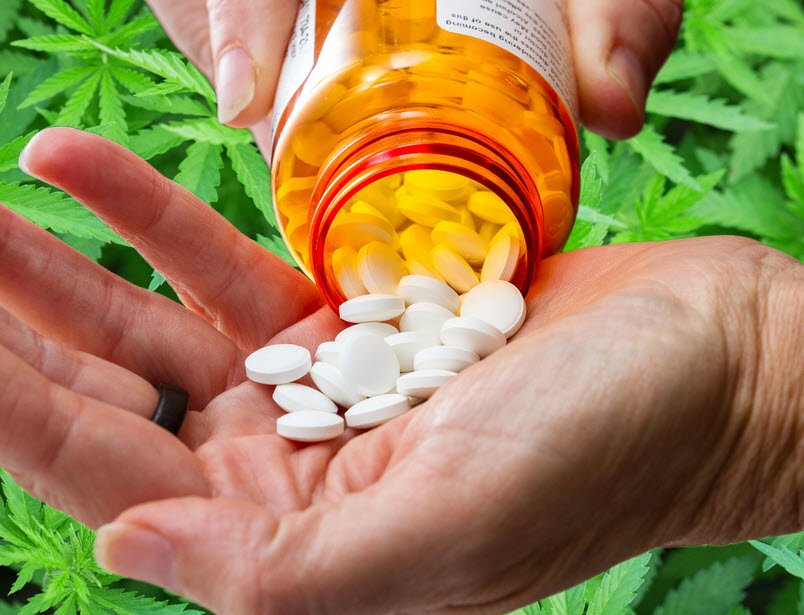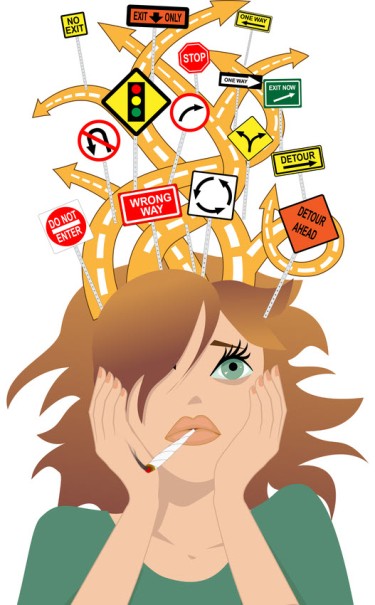Cannabis News
Can Magic Mushrooms Help with ADHD?
Published
9 months agoon
By
admin

Magic Mushrooms and ADHD: What The Research Says
With over 366 million adults around the world (as of 2020) still struggling with attention deficit hyperactivity disorder (ADHD), it’s clear that we still have a long way to go in terms of treating this neuro-developmental disorder.
The primary markers of ADHD are persistent hyperactivity and a chronic inability to focus, so much so that it interferes with an adult or child’s ability to function normally. There are several other ADHD symptoms, though they usually fall under either inattention or impulsivity. These can make it difficult to succeed academically and professionally, as well as in social settings and in personal relationships.
Given how common ADHD is, there have been many different types of medications that have been developed to help patients manage and reduce symptoms in all stages of life. Typically, a combination of medicines, lifestyle changes, and various types of therapy have been found to be effective for patients though there is no one-size fits-all solution. When it comes to medications, various stimulants and non-stimulants may be prescribed to patients.
Recently, cannabis or cannabis oil has also been shown to be effective as an adjunct therapy for ADHD, complimenting existing treatments given to patients. Cannabis, being all natural and non-addictive, helping to activate the reward system in the brain – thereby enabling the production of more dopamine than usual. Both THC and CBD have been shown to offer benefits for individuals with ADHD, acting in different ways within the body.
Now, thanks to the current psychedelic revolution, we’re discovering that magic mushrooms may just be among the psychedelic drugs that can also help with ADHD.
What New Studies Say
According to a recent study published in the journal, Frontiers in Psychiatry, microdosing magic mushrooms can help with focus and concentration, benefiting patients with ADHD. After all, disassociating and spacing out are some of the most common symptoms of ADHD.
For the study, the investigators analyzed 233 adults who were either diagnosed with ADHD or had symptoms similar to the condition; all of them expressed curiosity in microdosing. Eline C. H. M. Haijen, the study’s author and a PhD candidate at the Maastricht University’s Department of Neuropsychology and Psychopharmacology explains to PsyPost that some 3% of adults have ADHD and its hallmark symptoms are debilitating. “Some studies even suggest that emotion regulation should be considered a core component of ADHD, as it is experienced by up to 70% by adults with ADHD. Emotion regulation involves all attempts to influence emotional experience and responses. For example, it may involve the ability to reinterpret an emotion-eliciting situation (i.e., cognitive reappraisal), but also the inhibiting strong positive and negative emotional responses (i.e., expressive suppression),” she adds.
Empathy, says Haijen, is related to emotion regulation. When emotional regulation, and/or empathy are affected, individuals’ social and emotional functions will also be affected.
Not one but two studies were thereby conducted to best determine if microdosing psychedelics had an impact on adults who were struggling with severe ADHD symptoms. They found that after 4 weeks of microdosing, the first study participants reported drastic improvements when it came to emotional regulation as well as empathy. Their scores for cognitive reappraisal also saw improvements, which suggested that the participants had better tools for dealing with tense or emotional situations that helped them reduce their negative impact. In addition, they saw a reduction in expressive suppression, which suggests that the participants weren’t trying to withhold their emotional response, which is a much healthier way to deal with one’s emotions.
Interestingly, the researchers also noted better perspective-taking scores.
Meanwhile, the second study used a control group for a more thorough analysis. They studied individuals with ADHD who were using their standard ADHD medications though they weren’t microdosing. This was done in order to give them a better idea of how traditional ADHD medications fared compared to microdosing. They found that the group who was microdosing reported more dramatic improvements in ADHD symptoms especially in terms of emotional regulation, but there were no significant differences between the two when they assessed cognitive reappraisal.
“We compared individuals with ADHD who were microdosing to individuals with ADHD who were using conventional ADHD medication,” explained Haijen to PsyPost. “We found that microdosing, compared to conventional ADHD medication, induced positive effects on core ADHD symptoms and one aspect of emotional regulation, expressive suppression, which might indicate improved emotion regulation after four weeks of microdosing compared to baseline,” she said.
Why We Need More ADHD Drugs In The Market
Breakthroughs such as the use of magic mushrooms or marijuana for ADHD are important, and always will be.
Just because some medications that work in the market doesn’t mean it will always stay that way. Keep in mind that patients can actually develop resistance to treatment over time, which will inevitably reduce the effectiveness of any medicine. New treatments and medications being developed are essential so that ADHD patients can be offered alternative therapeutics if they are no longer responding to their current medicines.
We specifically need more natural and plant-based medications for ADHD, just like magic mushrooms and cannabis. That’s because stimulants and other conventional treatments for ADHD have questionable safety when it comes to long-term use. Meanwhile, cannabis and mushrooms are safer for use in the long run.
It also needs to be said that the side effects of common ADHD prescription drugs, such as Adderall and Ritalin, can often be so horrible that they patients taking them from living a normal quality of life – on top of ADHD symptoms at that. For example, Ritalin’s side effects include headaches, nervousness, anxiety, appetite loss, dizziness, and stomach pain among others. Meanwhile, Adderall is known to cause insomnia, elevated blood pressure and heart rate, dry mouth, dizziness, heart problems, mental health problems, and much more.
Conclusion
While we need more studies delving deep into the benefits of magic mushrooms and psychedelics for ADHD, it’s clear that this is a promising therapeutic alternative to traditional ADHD drugs. While this condition may be notoriously hard to treat, there’s now more hope than ever.
CANNABIS AND ADHD MEDS, READ ON…
You may like
-


Is Cannabis Legal in California Right Now?
-


Germany: Trial against operator of Trier cannabis vending machine discontinued
-


The best energizing THC gummies of 2025 by Leafly
-


Mixed Messages From The Feds About Cannabis
-


Humboldt County extends deadline to pay marijuana cultivation taxes
-


How Hemp Helps You Sleep
Cannabis News
Is Cannabis Legal in California Right Now?
Published
8 minutes agoon
March 29, 2025By
admin

California Supreme Court Upholds Cannabis Legalization
In a landmark decision, the California Supreme Court recently reaffirmed the legality of cannabis in the state by de-publishing a prior appellate ruling. This move effectively prevents the lower court’s opinion from being used as legal precedent in future cases, ensuring that California’s cannabis laws remain intact. The decision is a significant victory for the state’s legal cannabis industry and reinforces California’s position as a leader in cannabis legalization.
Background of the Case
The case, JCCrandall v. County of Santa Barbara, originated from a lawsuit filed by Lompoc property owner Janna Caron Crandall. She challenged the County of Santa Barbara’s decision to allow cannabis transportation on an easement road crossing her property. Crandall argued that the easement’s terms prohibited federally illegal activities, thus making the county’s permit approval unlawful. This challenge was rooted in the fact that cannabis remains illegal under federal law, despite being legalized in California.
The Legal Framework
California legalized recreational cannabis in 2016 with the passage of Proposition 64, also known as the Adult Use of Marijuana Act (AUMA). This law allowed adults 21 years and older to possess and use cannabis for recreational purposes. However, the federal government still classifies cannabis as a Schedule I controlled substance, making it illegal under federal law. This dichotomy between state and federal laws has created legal complexities and challenges for cannabis businesses operating in California.
The Appellate Court Ruling
In January 2025, the Court of Appeal sided with Crandall, suggesting that California’s cannabis regulations were unlawful due to cannabis being federally illegal. This ruling was seen as a potential threat to the state’s cannabis industry, as it implied that federal law could preempt state laws allowing cannabis use and sale. The appellate court’s decision was based on the argument that the easement agreement prohibited activities that were illegal under federal law, and since cannabis is federally illegal, allowing its transportation on the easement would violate the terms of the agreement.
Implications of the Appellate Ruling
If the appellate court’s decision had stood, it could have had far-reaching implications for California’s cannabis industry. It would have potentially opened the door for similar challenges to cannabis operations across the state, undermining the legal framework that has been established since Proposition 64. This could have led to increased legal uncertainty and risk for cannabis businesses, potentially stifling growth and investment in the sector.
The Supreme Court Decision
The California Supreme Court’s decision to de-publish the appellate court’s ruling effectively nullifies its impact as a legal precedent. This means that the opinion cannot be cited or relied upon in future cases, ensuring that California’s cannabis laws remain secure. The Supreme Court’s action was in response to a request from the Department of Cannabis Control and other stakeholders who sought to protect the state’s cannabis regulations.
Statement from the Department of Cannabis Control
“We are pleased that the Court agreed to address that Court of Appeal decision at the Department of Cannabis Control’s request, supporting California law and its legal cannabis industry,” said DCC Director Nicole Elliott. This statement reflects the relief and support within the industry and regulatory bodies for the Supreme Court’s decision.
Impact of the Supreme Court Decision
The Supreme Court’s decision has several key implications for California’s cannabis industry and the broader legal landscape:
-
Legal Certainty: By preventing the appellate court’s opinion from being used as precedent, the Supreme Court has provided legal certainty for cannabis businesses. This clarity is crucial for investors, operators, and consumers alike, as it ensures that the industry can continue to operate without the threat of federal preemption being used to undermine state laws.
-
Industry Growth: The decision supports the continued growth and development of California’s cannabis industry. With legal certainty, businesses are more likely to invest in expansion, innovation, and compliance, which can lead to increased economic benefits for the state.
-
Regulatory Framework: The ruling reinforces the authority of state regulatory bodies, such as the Department of Cannabis Control, to oversee and enforce cannabis laws. This ensures that the industry operates within a well-defined legal framework, which is essential for maintaining public safety and trust.
-
Consumer Access: For consumers, the decision means that access to legal cannabis will remain unchanged. This is important for both recreational users and patients who rely on cannabis for medical purposes.
-
Federal-State Relations: While the decision does not change federal law, it underscores the ongoing tension between state and federal cannabis policies. It highlights the need for continued advocacy for federal reform to align with the growing number of states that have legalized cannabis.
Historical Context of Cannabis Legalization in California
California has been at the forefront of cannabis legalization efforts in the United States. The state’s journey towards legalizing cannabis began with the passage of Proposition 215 in 1996, which allowed for the medical use of cannabis. This was followed by Proposition 64 in 2016, which legalized recreational cannabis.
Proposition 215: Compassionate Use Act
Proposition 215, also known as the Compassionate Use Act, was a groundbreaking piece of legislation that allowed patients with certain medical conditions to use cannabis with a doctor’s recommendation. This law marked the beginning of a shift in public perception and legal treatment of cannabis, paving the way for broader legalization efforts.
Proposition 64: Adult Use of Marijuana Act (AUMA)
Proposition 64 expanded on Proposition 215 by legalizing the recreational use of cannabis for adults. It established a regulatory framework for the cultivation, distribution, and sale of cannabis, creating a multibillion-dollar industry in California. The law also included provisions for taxation, licensing, and environmental protection.
Challenges and Opportunities in the Cannabis Industry
Despite the legal victories, the cannabis industry in California faces several challenges:
-
Regulatory Compliance: Businesses must navigate complex state and local regulations, which can be costly and time-consuming. Compliance with these regulations is essential to avoid legal issues and maintain operational licenses.
-
Market Competition: The California cannabis market is highly competitive, with many licensed operators competing for market share. This competition can drive innovation but also poses challenges for smaller businesses trying to establish themselves.
-
Federal Banking Restrictions: Due to federal illegality, cannabis businesses often face difficulties accessing traditional banking services. This forces many companies to operate largely in cash, which can increase security risks and complicate financial management.
-
Environmental Concerns: Cannabis cultivation can have environmental impacts, such as water usage and energy consumption. The industry Is working to address these concerns through sustainable practices and regulatory compliance.
-
Social Equity Programs: California has implemented social equity programs aimed at supporting individuals and communities disproportionately affected by the war on drugs. These programs provide resources and opportunities for entry into the cannabis industry.
Future of Cannabis Legalization
The California Supreme Court’s decision is part of a broader national conversation about cannabis legalization. As more states legalize cannabis, there is growing pressure for federal reform. Several bills have been introduced in Congress to address issues such as banking access and federal preemption, but comprehensive reform remains elusive.
Federal Reform Efforts
Efforts to reform federal cannabis laws include bills like the MORE Act, which would decriminalize cannabis at the federal level, and the SAFE Banking Act, which aims to provide banking access to cannabis businesses. While these bills have seen progress, they face significant hurdles in becoming law.
International Perspectives
Internationally, countries like Canada and Uruguay have fully legalized cannabis, providing models for how federal legalization could work. These countries have established national regulatory frameworks that address issues like taxation, public health, and international trade.
Conclusion
The California Supreme Court’s decision to uphold the legality of cannabis in the state is a significant victory for the industry and its stakeholders. It ensures that California can continue to lead in cannabis legalization and regulation, providing a model for other states and countries. As the legal landscape evolves, it is crucial for ongoing advocacy and reform efforts to address the remaining challenges and opportunities in the cannabis sector.
CANNABIS IN CALIFORNIA HAS PROBLEMS, READ ON…
Cannabis News
Daily Cannabis Use Can Help People Get Off Opioids (STUDY)
Published
1 day agoon
March 28, 2025By
admin

Cannabis daily can help people get off opioids (STUDY)
As Donald Trump continues to trudge on in his second term, he’s made it abundantly clear that tackling the fentanyl crisis is high on his agenda. The rhetoric is bold and aggressive – promises to go after cartels with military force, threats against drug dealers, and a generally hawkish stance toward drug trafficking. It’s the kind of tough talk that plays well to his base, but the question remains: will it actually solve anything?
If we look at his appointments and policy directions, it seems we’re heading for War on Drugs 2.0 rather than an innovative approach to a complex problem. History has taught us that you can’t simply bomb, arrest, or threaten your way out of drug epidemics. These tactics have been tried for decades with little success.
There is, however, one solution hiding in plain sight that could revolutionize Trump’s approach to the opioid crisis – cannabis legalization. Yes, you read that correctly. If Trump were to take the bold step of federally legalizing cannabis, he could potentially cement his legacy as one of the most transformative presidents in modern history.
It sounds counterintuitive at first – fighting drugs with another drug? But the evidence is mounting that cannabis could be a powerful weapon against opioid addiction and overdose deaths. Recent studies are showing promising connections between cannabis use and reduced opioid dependency.
So how exactly would legalizing a plant help combat the deadliest drug crisis in American history? Well, let me tell you!
A groundbreaking study published last week in the journal Drug and Alcohol Review has added significant weight to the argument that cannabis could help combat the opioid crisis. The research, conducted by an eight-person team from the British Columbia Centre on Substance Abuse, the University of British Columbia, and Simon Fraser University, examined data from 1,242 people who used drugs while also living with chronic pain.
Their findings were striking: “Participants reporting daily cannabis use exhibited higher rates of cessation compared to less frequent users or non-users.” In other words, those who used cannabis every day were more likely to quit using opioids altogether. This effect was particularly pronounced among men, suggesting “potential differences in cannabis use behavior and effects” between sexes.
This isn’t an isolated finding. A growing body of research supports the idea that cannabis can serve as an effective substitute for opioids. A federally funded study found that in states with legal marijuana, prescriptions for opioid pain medications dropped significantly among commercially insured adults. Another study discovered that legalizing medical cannabis appeared to significantly reduce payments from opioid manufacturers to doctors specializing in pain management – further evidence that cannabis was replacing prescription painkillers.
Perhaps most compelling is the research linking cannabis legalization to reduced fatal opioid overdoses. One study estimated that recreational marijuana legalization “is associated with a decrease of approximately 3.5 deaths per 100,000 individuals.” When you consider that over 107,000 Americans died from drug overdoses in 2021 alone (with 75% involving opioids), the potential life-saving impact becomes clear.
The opioid crisis has ravaged communities across America, destroying families and costing the economy an estimated $1.5 trillion annually in healthcare costs, criminal justice expenses, and lost productivity. Cannabis legalization offers a multi-pronged solution: it provides a safer alternative for pain management, reduces dependency on opioids, and potentially saves thousands of lives each year.
Beyond addressing the opioid epidemic, legalizing cannabis would create hundreds of thousands of new jobs, generate billions in tax revenue, reduce unnecessary incarcerations (particularly in communities of color), and open up new avenues for medical research and international commerce.
For a businessman-turned-president like Trump, the economic case alone should be compelling. The question is whether he has the vision to seize this opportunity or if he’s too beholden to interests that benefit from prohibition – pharmaceutical companies, private prisons, and law enforcement agencies that rely on drug war funding. If he truly wants a slam dunk policy that would address the fentanyl crisis while creating jobs and stimulating the economy, cannabis legalization could be his legacy-defining move.
While we wait for politicians to catch up with science, those suffering from chronic pain or other conditions treatable with cannabis might consider a more immediate solution: growing your own medicine.
Now, let me be crystal clear – I’m not advocating breaking the law. If cannabis is illegal in your state, I don’t want you risking arrest and criminal charges. However, speaking personally, if I were suffering from chronic pain and had few options, I might consider a small, discreet grow operation of 2-4 plants. This would be my absolute secret – something I’d never discuss with anyone, ever.
The beauty of growing your own cannabis extends far beyond just having a supply of medicine. There’s something profoundly therapeutic about nurturing a plant from seed to harvest. You develop patience, attention to detail, and a deeper connection to the plant medicine you’re creating. It’s a relationship, not just a transaction.
When you grow your own cannabis, you also know exactly what’s in it. No pesticides, no mysterious contaminants – just pure plant medicine cultivated with care. You can select strains specifically bred for your conditions, whether that’s pain, anxiety, insomnia, or inflammation. The process puts the power of healing back in your hands.
Beyond the primary flower, home growers can make use of every part of the plant. Fan leaves can be juiced for their non-psychoactive cannabinoid content. Trim can be used to make topicals or edibles. Even the stems can be used to make teas or tinctures. Nothing goes to waste.
There’s also a significant cost advantage. A small home grow can produce enough medicine to last months, potentially saving thousands of dollars compared to dispensary prices. For those on fixed incomes or without insurance coverage for their conditions, this economic benefit can’t be overstated.
I firmly believe that any meaningful cannabis legalization bill must include provisions for home cultivation. Without the right to grow your own medicine, legalization is merely transferring authority from one controlling entity to another. It’s still authoritarianism masquerading as freedom, just with different gatekeepers.
The right to grow is fundamental to true cannabis freedom. It acknowledges the plant for what it is – a natural resource that should be accessible to all, not just those who can afford to purchase it from state-sanctioned vendors. Home cultivation empowers individuals to take control of their own health without excessive dependence on either the black market or corporate cannabis.
While we push for policy change at the federal level, let’s not forget that sometimes the most revolutionary act is simply planting a seed.
The evidence is overwhelming: we’re facing an unprecedented opioid epidemic that’s claiming thousands of American lives every year, and cannabis represents a viable, evidence-based solution to this crisis. The latest research confirming that daily cannabis use can help people quit opioids adds to the mountain of data supporting cannabis as a harm reduction tool.
Yet despite the scientific consensus, I’m not holding my breath for federal action. The sad reality is that most politicians on both sides of the aisle receive substantial funding from industries that benefit directly from cannabis prohibition – pharmaceutical companies pushing their own patented pain medications, private prison corporations dependent on drug offenders to fill beds, and police departments that receive military-grade equipment through drug war budgets.
These entrenched interests have billions of reasons to maintain the status quo, and they’ve proven remarkably effective at delaying meaningful reform for decades. Even as public opinion has shifted dramatically in favor of legalization, with roughly two-thirds of Americans now supporting it, policy changes creep along at a glacial pace.
Perhaps Trump, with his penchant for disruption and unpredictability, could surprise us all by embracing cannabis reform as part of his anti-fentanyl strategy. It would certainly align with his populist messaging and “America First” economic policies. A thriving legal cannabis industry would create jobs, boost tax revenues, and potentially save countless lives from opioid overdoses.
I can hope for such bold leadership, but I’ll continue preparing for the long, slow grind of incremental progress. In the meantime, the opioid crisis rages on, claiming lives that could potentially be saved with a plant that’s been used medicinally for thousands of years. If that’s not a tragedy of policy failure, I don’t know what is.
CANNABIS TO REDUCE OPIOID USE, READ ON…
DR. OZ SAYS CANNABIS CAN GET PEOPLE OFF OPIOIDS, HOW DOES IT WORK?
Cannabis News
The Future of Cannabis and Sleep Medicine
Published
2 days agoon
March 28, 2025By
admin

Have you ever wondered how cannabis might play a role in improving your rest? What if there was a natural, effective alternative to traditional medications for better relaxation? As the world of sleep medicine evolves, cannabis is becoming an increasingly popular option for those struggling with sleep disorders. Thanks to its natural properties, this plant offers a promising path to better rest, with the potential to reshape the future of sleep medicine.
How Cannabis Supports Restful Sleep
The best strain for sleep often contains a balanced combination of THC and CBD, the two primary compounds that have been linked to improved rest quality in multiple studies. THC is known for its ability to relax both the body and mind, making it easier to unwind and fall asleep. It can also extend the time spent in deep, restorative stages of rest. On the other hand, CBD works to reduce anxiety and stress, which are common causes of insomnia.
By addressing both the mental and physical factors that interfere with rest, cannabis offers a holistic approach to improving relaxation. In addition to aiding in sleep onset and depth, it may help alleviate disruptions caused by chronic pain, anxiety, or even nightmares in PTSD patients. For those searching for natural remedies, cannabis is quickly emerging as a powerful tool in the world of medicine.

Strain for Rest: Tailoring Your Experience
Depending on your needs, the strain for sleep can vary. While indica strains are generally favored for their deeply relaxing effects, hybrid strains offer a balance of relaxation without overwhelming sedation. For those who struggle with both falling asleep and staying asleep, strains high in both THC and CBD are popular choices.
THC is beneficial for falling asleep, while CBD may help maintain consistent, uninterrupted cycles of rest. Terpene profiles also play a significant role in determining the effects of cannabis, with terpenes like myrcene and linalool known for their calming properties. As the cannabis industry continues to grow, dispensaries are offering personalized recommendations based on individual needs, helping you find the right strain for better relaxation.

The Role of CBD in Medicine
CBD is rapidly becoming a cornerstone in the world of sleep medicine. Unlike THC, CBD is non-psychoactive and does not cause the “high” typically linked to cannabis. This makes it an appealing option for people looking to improve their rest without feeling intoxicated.
Research shows that CBD may help improve the quality of rest by reducing anxiety, promoting relaxation, and even alleviating symptoms of conditions that disrupt rest, such as pain or insomnia. It is often taken in tincture or capsule form, allowing for precise dosing. As a result, CBD is gaining popularity not only as a sleep aid but also as a long-term solution for maintaining a consistent rest routine.
Cannabis: A Natural Sleep Aid Alternative
Prescription aids have long been the go-to solution for those suffering from insomnia and other rest disorders. However, they come with a range of side effects, from grogginess to dependency. Cannabis offers a natural alternative that is both effective and less likely to cause adverse reactions. As more people look for alternatives to traditional sleep medications, cannabis is becoming an increasingly popular choice.
Unlike prescription drugs, cannabis works with the body’s natural systems, reducing the likelihood of dependence. Additionally, it helps with the underlying causes of sleep issues, such as anxiety and pain, making it a more holistic approach to rest medicine. This shift toward natural remedies signals a growing demand for plant-based sleep solutions. The future of sleep medicine looks brighter as cannabis continues to gain acceptance in this field.
What the Future Holds
As the cannabis industry evolves, the potential for it to revolutionize sleep medicine is enormous. In the future, more advanced research into cannabis’s specific effects on slumber can be expected, leading to better, more targeted treatments. With the rise of personalized medicine, cannabis will likely become a more tailored solution, offering customized blends of THC, CBD, and terpenes to address specific issues.
The future may also see the development of new delivery methods that make it easier and more efficient for consumers to experience restful slumber. Whether through edibles, tinctures, or even sleep-enhancing topicals, innovations in product formulations will make cannabis more accessible and effective than ever before. With increasing recognition of this plant’s benefits in sleep medicine, it is likely to become a cornerstone in achieving natural, restorative rest.
The future of cannabis in sleep medicine is bright, with endless possibilities for enhancing the quality of rest for those struggling with sleep issues. By experimenting with the best strain for sleep and choosing the right delivery method, consumers can unlock the benefits of this natural remedy and experience more restful nights. As cannabis continues to evolve, it will remain a valuable tool in improving sleep and overall wellness.

Is Cannabis Legal in California Right Now?

Germany: Trial against operator of Trier cannabis vending machine discontinued

The best energizing THC gummies of 2025 by Leafly

Mixed Messages From The Feds About Cannabis

Humboldt County extends deadline to pay marijuana cultivation taxes

How Hemp Helps You Sleep

420 in Texas is at Reggie & Dro

Daily Cannabis Use Can Help People Get Off Opioids (STUDY)

The Future of Cannabis and Sleep Medicine

This Wine Issue Is Becoming More Common

Distressed Cannabis Business Takeaways – Canna Law Blog™

United States: Alex Malyshev And Melinda Fellner Discuss The Intersection Of Tax And Cannabis In New Video Series – Part VI: Licensing (Video)

What you Need to Know

Drug Testing for Marijuana – The Joint Blog

NCIA Write About Their Equity Scholarship Program

It has been a wild news week – here’s how CBD and weed can help you relax

Cannabis, alcohol firm SNDL loses CA$372.4 million in 2022

A new April 20 cannabis contest includes a $40,000 purse

Your Go-To Source for Cannabis Logos and Designs

UArizona launches online cannabis compliance online course
Trending
-

 Cannabis News2 years ago
Cannabis News2 years agoDistressed Cannabis Business Takeaways – Canna Law Blog™
-

 One-Hit Wonders2 years ago
One-Hit Wonders2 years agoUnited States: Alex Malyshev And Melinda Fellner Discuss The Intersection Of Tax And Cannabis In New Video Series – Part VI: Licensing (Video)
-

 Cannabis 1012 years ago
Cannabis 1012 years agoWhat you Need to Know
-

 drug testing1 year ago
drug testing1 year agoDrug Testing for Marijuana – The Joint Blog
-

 Education2 years ago
Education2 years agoNCIA Write About Their Equity Scholarship Program
-

 Cannabis2 years ago
Cannabis2 years agoIt has been a wild news week – here’s how CBD and weed can help you relax
-

 Marijuana Business Daily2 years ago
Marijuana Business Daily2 years agoCannabis, alcohol firm SNDL loses CA$372.4 million in 2022
-

 California2 years ago
California2 years agoA new April 20 cannabis contest includes a $40,000 purse






